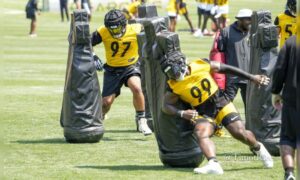It is apparent to the more than casual observer that the Pittsburgh Steelers have some issues when it comes to the defensive side of the ball. And while many tend to focus on their deficiencies in the passing game—highlighting the need for rush linebackers and cornerbacks, especially—they still have their shortcomings against the run.
One way to address this is to address the defensive line in the draft.
The Steelers do believe that they have their starting front three in place with Steve McLendon at nose tackle anchored by Cameron Heyward and Stephon Tuitt at defensive end. They also appear to be comfortable with the progress of second-year nose tackle Daniel McCullers, and, in truth, the internal growth of the young Tuitt and McCullers should help the run defense.
But the issue is, to my mind, the Steelers’ lack of quality depth available to them, with only two veteran journeyman-type, large-bodied defensive ends behind them with any playing experience.
While both Heyward and Tuitt have shown the capacity to log nearly a full game’s worth of snaps all on their own, the fact is that the defense as a whole would be better-served, particularly toward the beginning of the season, if they had quality reserves to rotate in and out of the game, and frankly nobody on the roster really qualifies sufficiently enough for me to refrain from taking a defensive end in the draft.
Coincidentally, the Steelers did finish up their pre-draft visits with Preston Smith, an interesting prospect who could be a versatile contributor in different roles in sub-packages. A player of his quality and maneuverability within the defense could, I think, do a lot to help the defense control the run game, if at the least by keeping the starters fresh.
Make no mistake, of course: there were many issues with the run defense last season. While the Steelers may have technically ranked sixth in giving up ‘just’ 100.3 yards on the ground per game, they also surrendered the seventh-most yards per carry in the league.
Why the discrepancy? As I have previously examined, it has much to do with the way that their opponents played the Steelers. They ran the ball little because they were so successful doing so early in the game and on first and second down that it opened up the passing game. As a result, Pittsburgh faced the third-least amount of carries last year, but gave up the fourth-most passing touchdowns.
Improving the run defense, particularly on first and second down, and forcing the opposition into predictable, rather than unpredictable, passing situations should be, I believe, the primary focus of getting the defense back on track.
Opponents last season chose not to run the ball because they found that they didn’t need to. This is much different than the 2010 season when opponents found that they could not run the ball, and thus resulted in among the fewest carries against in the league.
And while all levels of the defense must contribute to making the run defense work together as a whole, I think it starts with the defensive line, and it starts with adding quality depth to support the starting front three.








